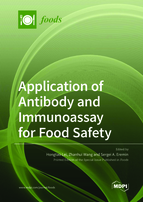Application of Antibody and Immunoassay for Food Safety
A special issue of Foods (ISSN 2304-8158). This special issue belongs to the section "Food Quality and Safety".
Deadline for manuscript submissions: closed (31 December 2021) | Viewed by 28579
Special Issue Editors
Interests: food authenticity; biosensor; chemometrics; food safety; food analysis; immunoassay; antibody engineering; hapten design
Special Issues, Collections and Topics in MDPI journals
Interests: hapten design for chemical compound in food; production of recognition materials; immunoassay for food safety; food science and quality; antibiotic resistance; environmental drugs and toxins; veterinary medicine; zoonosis
Special Issues, Collections and Topics in MDPI journals
Special Issue Information
Dear Colleagues,
Immunoassays are a class of analytical techniques wherein the reaction is based on highly specific molecular recognition between antibodies and antigens. Immunoassay has played a prominent role in the rapid detection of various analytes in food, including pesticides, veterinary drugs, heavy metals, hormones, allergens, food adulterants, natural components, biomarkers in food materials, etc.
Immunoreagents for food analysis are continuously developing during the last three decades, with hapten design leading to the possibility of using antibodies against non-common low molecular weight antigens and quantitative structure–activity relationship investigations, and structure biology approaches assisting toward a better understanding of the molecular recognition of epitope and antibody. In addition, novel antibodies such as various recombinant or fragment antibodies have contributed to the identification of various novel characteristics of antibodies in food safety.
A wide range of immunoassays have emerged in endlessly, ranging from conventional enzyme-linked immunosorbent assays (ELISA) and point-of-care tests typically represented by lateral flow immunochromatography assay (LFIA) to biosensors with various principles, full integration of lab-on-a-chip platforms, microfluidics, sensibilization employing novel nanomaterials, miniaturization and interfacing of portable devices, especially emerging smart system technologies equipped with intelligent smart phones, etc. New technologies are promoting the development of immunoassays and their application in food safety.
Thus, in order to promote the use of immunoassay for future developments in food analysis, the main goal of this Special Issue is to collect manuscripts that enable increasing the recent progress and broadening the novel knowledge about antibody and immunoassay for the detection of chemical and biological analytes such as pathogen, food contaminant, food fraud, and so on in the food safety area.
Prof. Dr. Hongtao Lei
Prof. Dr. Zhanhui Wang
Prof. Dr. Sergei A. Eremin
Guest Editors
Manuscript Submission Information
Manuscripts should be submitted online at www.mdpi.com by registering and logging in to this website. Once you are registered, click here to go to the submission form. Manuscripts can be submitted until the deadline. All submissions that pass pre-check are peer-reviewed. Accepted papers will be published continuously in the journal (as soon as accepted) and will be listed together on the special issue website. Research articles, review articles as well as short communications are invited. For planned papers, a title and short abstract (about 100 words) can be sent to the Editorial Office for announcement on this website.
Submitted manuscripts should not have been published previously, nor be under consideration for publication elsewhere (except conference proceedings papers). All manuscripts are thoroughly refereed through a single-blind peer-review process. A guide for authors and other relevant information for submission of manuscripts is available on the Instructions for Authors page. Foods is an international peer-reviewed open access semimonthly journal published by MDPI.
Please visit the Instructions for Authors page before submitting a manuscript. The Article Processing Charge (APC) for publication in this open access journal is 2900 CHF (Swiss Francs). Submitted papers should be well formatted and use good English. Authors may use MDPI's English editing service prior to publication or during author revisions.
Keywords
- antigen
- hapten
- antibody
- immunoassay
- biosensor
- food analysis
- contaminant
- food fraud
- residue
- QSAR
- molecular recognition









